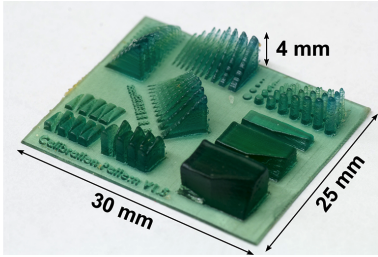MIT Develops Possible Holy Grail of 3D Printers–Prints Up to 10 Materials At Once for Under $7k
What’s the ultimate vision for 3D printers, say 30-50 years in the future? Many within the industry believe that eventually 3D printers will evolve into systems which operate sort of like the Replicator from Star Trek. Yes this certainly sounds like science fiction, but in fact, such a machine should one day be possible.
The first step on the way to developing a Star Trek Replicator, or the Holy Grail of 3D printers, is to get past the single material limitations that most machines have today. Sure, the typical desktop 3D printer can print using multiple types and colors of filament, thanks to multiple extruders, and the more sophisticated and expensive machines are able to print with resins which have multiple properties, but what about printing an object which has a  much wider array of materials on a machine that is available at a much cheaper price? That’s just what MIT’s Computer Science and Artificial Intelligence Laboratory (CSAIL) is trying to do, and they are already off to an incredible start.
much wider array of materials on a machine that is available at a much cheaper price? That’s just what MIT’s Computer Science and Artificial Intelligence Laboratory (CSAIL) is trying to do, and they are already off to an incredible start.
The 3D printer, which the researchers call the MultiFab, is a vision-assisted multi-material 3D printer capable of printing with 10 different materials within a single build, with a current material library consisting of 15 possibilities. Some of the materials included within the library are a rigid material (RIG), elastic material (ELA), high refractive index material (HR), low refractive index material (LR), and a support material (SPT)–and this library should continue to expand substantially with further research.
“We provide a significant library of printing materials, but there is virtually unbounded space for the development of materials that can be reliably 3D printed,” wrote the researchers in a recently released paper titled MultiFab: A Machine Vision Assisted Platform for Multi-material 3D Printing. “Examples include exploring the influence of different nano-particles on base materials and developing bio-compatible printing materials.”
Not only does the MultiFab 3D printer have a wide array of material options, but it can print incredibly fine details, with layer heights as small as 13 microns. Additionally, while most of you probably are wondering just how many digits are in the price of this machine, which happens to also feature an integrated 3D scanning system, the researchers were able to build it for an almost unbelievable $7,000.
The system works by utilizing multiple piezoelectric inkjet printheads from 2D printers, which have been specifically adapted for 3D printing to eject photosensitive materials onto a  build platform or upon already printed layers of an object. Just like with any typical stereolithography (SLA) 3D printer, a UV light then cures the material as it’s placed down. The construction of the printer has been based on a modular architecture which allows for quick and easy swapping of components on the fly.
build platform or upon already printed layers of an object. Just like with any typical stereolithography (SLA) 3D printer, a UV light then cures the material as it’s placed down. The construction of the printer has been based on a modular architecture which allows for quick and easy swapping of components on the fly.
The integrated 3D scanner is not only used to create printable models for replicating objects, but also is an integral part of the system’s feedback loop. The scanner is able to send data back to the computer making sure that the item that’s being fabricated is being done so correctly, adjusting to any errors which may occur within the print process.
The researchers have already printed numerous objects, each consisting of multiple materials. Some of these objects printed include an LED with an integrated lens, complex meta-materials, privacy screens for smartphones, a microlens array, and optical fiber bundles.
While there is still a ways to go before anything comparable to a Replicator from Star Trek is possible, these are the first steps in the process. The fact that these researchers were able to produce a machine with such capabilities at a price which falls under $10,000 is a major accomplishment in itself.
Discuss this awesome new 3D printer in the MultiFab 3D Printer forum thread on 3DPB.com. Check out the video below showing this 3D printer in action:
Subscribe to Our Email Newsletter
Stay up-to-date on all the latest news from the 3D printing industry and receive information and offers from third party vendors.
Print Services
Upload your 3D Models and get them printed quickly and efficiently.
You May Also Like
AMT Shakes Up 3D Printing Market with Affordable, High-Performance Post-Processing Consumables
Additive Manufacturing Technologies (AMT), a global leader in automated 3D printing post-processing, is launching a new line of consumables that promises to significantly reduce operational costs for additive manufacturing users....
The Bambu Lab 3D Printing Platform… or Trapdoor?
Bambu Lab began as a completely closed 3D printing system, where the printer, software, and materials all functioned well but were exclusively from the company itself. This approach mirrored Formlabs,...
2025 Renault 5 E-Tech Electric Is Latest Car with 3D Printed Accessories
Due to the required numbers, additive manufacturing (AM) has struggled to make significant inroads into vehicle interiors in meaningful numbers—at least as far as public knowledge is concerned. Typically an...
BMW Completes Project to Automate Plastic 3D Printing
After a three-year journey to efficiently scale polymer 3D printed part production, the POLYLINE project has concluded. This endeavor, headquartered at BMW’s Additive Manufacturing Campus, pooled the expertise of EOS,...
































